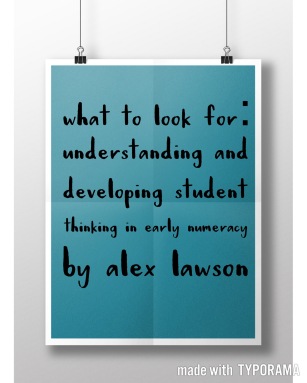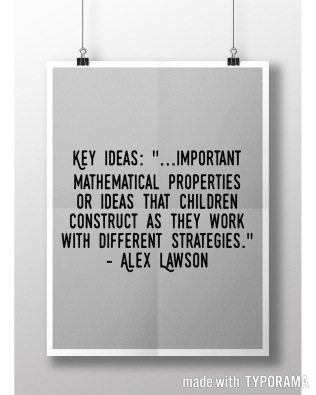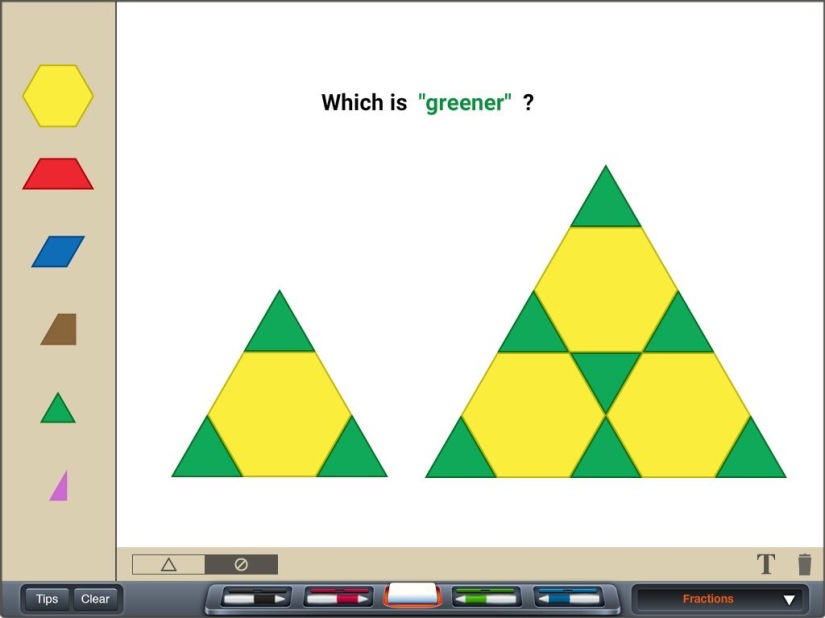This Summer some colleagues and I are reading a great book together! This is the first time in a while I have done a face-to-face book club, so I am kind of excited about it. We’re getting together in a few weeks to talk about it! Writing helps me to process my thinking, so I am going to write about each chapter as I read.

There aren’t many pages in this chapter. I read it in under ten minutes. But I think there are some important things here.
Alex Lawson defines strategies and key ideas in this chapter. These are important to understanding the rest of the book, and really they help with any math teaching conversation, not to mention actual math teaching. They are helpful for that too.

This word, strategies, is one I hear a lot in teaching. I like this definition. It think it applies to reading and writing instruction too, expect there I think we learn more about which strategies students are using when we have conversations with them. They don’t necessarily show their thinking on paper during reading like they do during math. )(Bonus: Here is what Jennifer Serravallo says about strategies and skills…all related to literacy work of course, but still an interesting perspective if you ask me.) In literacy, the goal is that the strategies eventually shift to the background and the child can now be said to have a skill. For example, when an emergent reader encounters an unknown word, s/he will use some strategies such as “skip ahead” or “consider context” to figure out the word. S/he will actively consider which strategy to use in a given situation, try a new strategy if the first didn’t work, etc. But by the time that same child is a reading proficiently s/he doesn’t have to consciously consider which strategy to use. Figuring out new words just happens while the child focuses on the meaning of the text. I’m not sure if this happens in math. I guess it does. Normal people, not teachers who are analyzing their own work to think about the strategy they used, must just add things up and subtract things without thinking about what they do. I should ask someone who isn’t a teacher about this. I wrote last week about asking my niece and nephew math questions. (here) Maybe this is something for me to pursue with them! (I know! Don’t you wish you could come to a family dinner at my house?)
I’m rambling again.
My love for Cathy Fosnot runs deep, so I went to look for her definition of “strategies” and found it is much the same. “Strategies can be observed. They are the organizational schemes children use to solve a problem; for example, they might count by ones, skip-count, or use doubles.” (Found here.) Her Landscapes of Learning are detailed lists of strategies one would expect to see students use while problem solving in a variety of areas. In this book, Alex Lawson’s book, the one I am supposed to be writing about, there are great summaries of all the accompanying videos. Each summary lists the strategies the child in the video used to solve the problem. On Page 15, for example, the child in that video used counting three times, counting on/counting back, counting on from the larger number, etc. I’m looking forward to understanding more strategies that students might use in my class. I think I’m getting pretty good at this, but I still tend to think of one strategy first and forget to think about other ways to solve problems. This is especially true if I happen to be faced with some math that is actually matches my personal ability level as a mathematician.
In chapter 1, Lawson also gives us her definition of “key ideas.” (Fosnot calls these “big ideas”) .

The key ideas shown in each video are also listed on the charts in the book, and defined in various places. I went in search of some other information about key ideas, or big ideas. The Ontario Math Curriculum defines some of them in the glossary, but they are mixed in with all the other terms rather than highlighted. It’s still a good resource, if you ask me. It starts on page 120. Cathy Fosnot says this here.
“Underlying these strategies are big ideas. Big ideas are “the central, organizing ideas of mathematics—principles that define mathematical order”(Schifter and Fosnot 1993, 35). Big ideas are deeply connected to the structures of mathematics. They are also characteristic of shifts in learners’ reasoning—shifts in perspective, in logic, in the mathematical relationships they set up. As such, they are connected to part-whole relations—to the structure of thought in general (Piaget 1977). In fact, that is why they are connected to the structures of mathematics. Through the centuries and across cultures as mathematical big ideas developed, the advances were often characterized by paradigmatic shifts in reasoning. That is because these structural shifts in thought characterize the learning process in general. Thus, these ideas are “big” because they are critical ideas in mathematics itself and because they are big leaps in the development of the structure of children’s reasoning. Some of the big ideas you will see children constructing as they work with the materials in this package are unitizing, compensation, and equivalence.”
I know Cathy Fosnot is not the author of this book, but I am trying to connect to what I already know, love, and understand (more or less.) So here is a video of her talking about “Big Ideas, Strategies and Modelling”. I love how she says that developing Big Ideas represents a cognitive shift for the student. They show that a student is now understanding and using something they didn’t know before. It causes them to undo previous ideas and reorganize their thinking. If you want to here Cathy Fosnot talk more about this, try “week three” in the Not a Book Study webcasts. (here)
So there you have it. My summary and thinking which is probably longer than the chapter itself. I’m anxious to get going on the videos and reading in the remaining chapters of the book, and very excited about the Teacher’s Math Kit in the second half of the book (and I use “half” here to mean the second part. I haven’t actually mathematized this book to see if it is truly the second HALF.)
A word about the book club: occasionally people I know in my real life say they are reading this blog. If you are, and you’re thinking, “Hey! I want to be in the book club!!” then send me a note. Comment here, or find me on Twitter (@LisaCorbett0261), or use my board e-mail. It’s going to be happening on August 9, 2017 in my back yard. Unless it rains like it has most of this Summer. Then we’ll find an alternate spot. Either way, kids are invited and it’s a pot luck lunch. And if I don’t know you in real life and you want to come anyway, well, we can probably work something out.





You must be logged in to post a comment.